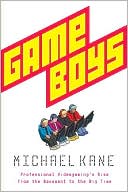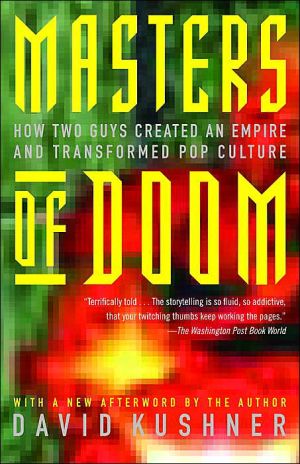Playing with Power in Movies, Television, and Video Games: From Muppet Babies to Teenage Mutant Ninja Turtles
How do children today learn to understand stories? Why do they respond so enthusiastically to home video games and to a myth like Teenage Mutant Ninja Turtles? And how are such fads related to multinational media mergers and the "new world order"?\ In assessing these questions, Marsha Kinder provides a brilliant new perspective on modern media.
Search in google:
"A very productive, thought-provoking analysis of new transformations in today's narrative media and their interpretations of the child-spectator."—Dana Polan, Editor,Cinema Journal Publishers Weekly Parents who worry that playing video games will turn their kids' brains to mush may welcome Kinder's view that the games contribute to a ``ripening process . . . by fostering equilibration, by demanding shifting identifications with a wide range of subjects and objects, by forcing children to use the inductive process.'' This academic treatise swings between claims for the ostensible benefits of kiddies' TV shows, cartoons, videos and video games, and an analysis of how these same media instill an illusory sense of empowerment in children, serve as substitute parents and transmit consumerist ideology. The author, a professor at the University of Southern California School of Cinema-Television, psychoanalytically interprets the meanings of Muppet figures and applies semiotics to Garfield the Cat as one might hit a flea with a sledgehammer. Photos. (Nov.)
Playing with Power in Movies, Television, and Video Games\ From Muppet Babies to Teenage Mutant Ninja Turtles \ \ By Marsha Kinder \ University of California Press\ Copyright © 1991 Marsha Kinder\ All right reserved. \ ISBN: 0-520-07570-6 \ \ \ \ Chapter One\ Foreplay and Other Preliminaries \ A long time ago there were no toys and everyone was bored. Then they had TV, but they were bored again. They wanted control. So they invented video games. -Victor Aurelio Bautista\ According to my eight-year-old son, Victor, who is a reluctant moviegoer as well as our household Nintendo champion, the history of entertainment is driven by the pleasure principle-the alleviation of boredom and the pursuit of control or mastery. Cinema (which he omits entirely from his minihistory) is clearly expendable.\ Apparently, postmodern kids like Victor need to be sold on the concept that movies still have an essential place in the entertainment system. Both Saturday morning television and home video games perform this job of selling by refiguring cinema not as a medium that is obsolete, but as what Beverle Houston calls "a prior discourse" that can be parodied, recycled, and mastered. Thus, even before children go to the cinema, they learn that movies make a vital contribution to an ever-expanding supersystem of entertainment, one marked by transmedia intertextuality.\ Intertextuality, Dialogism, and Sliding Signifiers\ The term intertextuality was first introduced by Julia Kristeva, elaborating on Mikhail Bakhtin's concept of dialogism. According to Bakhtin, "The linguistic significance of a given utterance is understood against the background of language, while its actual meaning is understood against the background of other concrete utterances on the same theme, a background made up of contradictory opinions, points of view and value judgments." In contemporary media studies, intertextuality has come to mean that any individual text (whether an artwork like a movie or novel, or a more commonplace text like a newspaper article, billboard, or casual verbal remark) is part of a larger cultural discourse and therefore must be read in relationship to other texts and their diverse textual strategies and ideological assumptions. As Robert Stam puts it, "In the broadest sense, intertextuality or dialogism refers to the open-ended possibilities generated by all the discursive practices of a culture, the entire matrix of communicative utterances within which the artistic text is situated, and which reach the text not only through recognizable influences but also through a subtle process of dissemination." Thus, even if the author or reader of a particular text is not consciously aware of the other texts with which it is connected, those texts still help to structure its meaning.\ In this book I will focus primarily on intertextual relations across different narrative media. As a means of structuring events within patterns of space, time, and causality, narrative creates a context for interpreting all perceptions. Narrative maps the world and its inhabitants, including one's own position within that grid. In acquiring the ability to understand stories, the child is situated as a perceiving, thinking, feeling, acting, speaking subject within a series of narrative fields-as a person in a family saga, as a spectator who tunes in to individual tales and identifies with their characters, and as a performer who repeats cultural myths and sometimes generates new transformations. Ever since television became pervasive in the American home, this mass medium has played a crucial role in the child's entry into narrative. My study explores how television and its narrative conventions affect the construction of the subject.\ In assimilating and redefining that "prior discourse" of cinema, both Saturday morning television and home video games cultivate a dual form of spectatorship. They position young spectators to combine passive and interactive modes of response as they identify with sliding signifiers that move fluidly across various forms of image production and cultural boundaries, but without challenging the rigid gender differentiation on which patriarchal order is based. Although the meanings of all signs tend to be multiple and slippery, by sliding signifiers I refer specifically to those words, images, sounds, and objects that-like the pronouns I and you, or the adverbs here and there-blatantly change meaning in different contexts and that derive their primary value precisely from that process of transformation.\ This combined mode of spectatorship helps to account for the extraordinary success of that commercial supersystem of transmedia intertextuality constructed around Teenage Mutant Ninja Turtles, those ultimate sliding signifiers who transgress every important border, except gender. Within this Turtle network, young players are encouraged to define themselves not in opposition to the alien Other but as voracious consumers-like Pac-Man, who defeats enemies by eating them. Thus, like the protean Turtles, who imitate old masters (both the Italian Renaissance artists after whom they are named and the Japanese ninja warriors whose martial arts skills they practice), children are learning to function as transformative mutants.\ In adapting both this transcultural legacy and themselves to a new supersystem in which they prove their own mastery, the Ninja Turtles dramatize the interrelated processes of assimilation and accommodation-concepts central to Jean Piaget's theory of genetic epistemology. Piaget claims that "in order to know objects, the subject must act upon them, and therefore transform them"; in turn, the subject is transformed, in a constant process of "reequilibration." In this book I will demonstrate how children's television and home video games construct consumerist subjects who can more readily assimilate and accommodate whatever objects they encounter, including traditional modes of image production like cinema and new technological developments like interactive multimedia.\ Consumerist Interactivity\ We are now on the verge of an interactive multimedia revolution that is already placing cinema, television, VCR's, compact disc players, laser videodisc players, video games, computers, and telephones within a consolidated supersystem combining home entertainment, education, and business. Journalists are prophesying that "through the marriage of computers and film," soon "people will be able to pick up the fiber-optic phone line, access any listing, say, in the Paramount or ABC libraries, punch in a code and, within minutes, have Singin' in the Rain or a documentary on civil-rights violations flash across a wall-sized, high definition screen." The latest developments in interactive media (such as Compact Disc Interactive, developed by Sony and Philips, and Digital Video Interactive, developed by General Electric and Intel Corporation) promise consumers that, with the purchase of an electronic device (which, like a Nintendo home video game system, can be hooked up to any television set) and the use of a remote control unit or "joystick," they will be able to access and combine a wide range of graphics, video images, sounds, words, and data bases. The vast range of applications for this cutting-edge technology in science, business, education, and entertainment can already be seen and played with at interactive multimedia galleries like Tech 2000 in Washington, D.C.\ We have already seen the rise of popular interactive TV programs like "America's Funniest Home Videos," the success of which was made possible by the wide availability of affordable video-8 camcorders of high quality. On this show the audience not only votes for their favorite video, but also provides the entertainment by documenting their own experience. Like public access programming on cable television, such developments have the potential to democratize the video medium-a potential most fully realized in the recent Eastern European revolutions, where populist video both documented and participated in the making of history. In the United States, roving spectators with camcorders are increasingly documenting the impromptu violence they happen to witness in urban streets (as in the case of black motorist Rodney Glen King, whose severe beating by several policemen in Los Angeles in March 1991 was captured by a passing observer and broadcast on national television-an instance of video vérité that led to charges being brought against some of the officers and a bitter political struggle to force Police Chief Daryl F. Gates to resign). Yet on American prime time, this democratic potential is being used primarily to document comical pratfalls staged in the home for prizes, fame, and fun. Although home video and pirate radio have been celebrated in such recent films as sex, lies, and videotape (1989) and Pump Up the Volume (1990), where they function both as masturbatory fantasy and as a means of politicizing depressed housewives and teens, in the United States the democratic potential of interactive mass media has largely been appropriated by commercial interests.\ In an analysis of interactive television of the 1980s, Andrew Pollack concludes: "So far, the only interactivity that appears to be developing into a successful business is the simplest approach, requiring no special equipment in homes... allowing viewers to order merchandise on shopping networks, by calling an '800' telephone number or to respond to questions on television by calling a '900' number." Although he focuses on quiz shows like Jeopardy and Wheel of Fortune, which encourage viewers to play along, prize competitions in which one predicts the next music video or the quarterback's next call, and viewer voting contests for the best outcome of a mystery show or the funniest home video, he acknowledges that interactive television may have a better chance in the 1990s because "years of exposure to video games and computers mean that consumers now are more acclimated to interactivity." Pollack nevertheless warns that the success of these systems will be determined by "how well such services can attract and serve advertising." The more experimental interactive developments in modern media are beyond the scope of my project. Rather, I will focus here on how Saturday morning television and home video games, and their intertextual connections with movies, commercials, and toys, help prepare young players for full participation in this new age of interactive multimedia-specifically, by linking interactivity with consumerism.\ Cognitive Theory and the Gendered Spectator/Player\ To theorize about these new interactive media, we cannot restrict ourselves to the passive models of spectatorship rooted in psychoanalysis (which have tended to dominate film studies) but must also consider cognitive theory. To this end, I will use Piaget's theory of genetic epistemology, which foregrounds the interrelated processes of assimilation and accommodation in the cognitive development of the child; the empirical work of Arthur Applebee, which applies this model (as well as the cognitive theories of L. S. Vygotsky and Jerome Bruner) to the child's interaction with narrative; and the writings of Seymour Papert, who applies Piaget's model to the child's interaction with computers.\ In The Child's Concept of Story: Ages Two to Seventeen, Applebee describes two modes of responding to narrative that can be found in early childhood and that develop collaboratively through later cognitive phases. This combination evokes the dual player/spectator position constructed for children by Saturday morning television and home video games. According to Applebee, in the "interactive participant role" (already observable in the infant's earliest dealings with the physical world), the child as perceiving/acting subject responds "piecemeal" to narrative discourse, and visual and verbal representations generate immediate concrete action, enabling the infant to handle, survive, or control events. In the "spectator role" (observable by age two and a half), the various systems of representation become fully involved and integrated as an "aesthetic" experience; the perceiving subject now responds to the whole. Like Piaget, Applebee assumes that "as children mature, they do not pass out of one mode of response into another, but integrate their older structures into a new and more systematic representation of experience." Although focused primarily on the spectator response, his study suggests that the interactive participant role is what drives the major shifts to later cognitive stages.\ Piaget's theory of genetic epistemology distinguishes four principal stages of cognitive development, which follow the formation of sensorimotor intelligence:\ (1 1/2-2 years), there begins a period which lasts until nearly 4 years and sees the development of a symbolic and preconceptual thought.\ From 4 to about 7 or 8 years, there is developed, as a closely linked continuation of the previous stage, an intuitive thought whose progressive articulations lead to the threshold of the operation.\ From 7-8 to 11-12 years "concrete operations" are organized, i.e. operational groupings of thought concerning objects that can be manipulated or known through the senses.\ Finally, from 11-12 years and during adolescence, formal thought is perfected and its groupings characterize the completion of reflective intelligence.\ Within each new cognitive stage, Piaget claims that "the fundamental factor of development" is equilibration, which he defines as "a sequence of self-regulations whose retroactive processes finally result in operational reversibility." According to Piaget:\ A mental operation is reversible when, starting from its result, one can find a symmetrically corresponding operation which will lead back to the data of the first operation without these having been altered in the process.... If I divide a given collection of objects into four equal piles, I can recover the original whole by multiplying one of my quarters by four: the operation of multiplication is symmetrical to that of division. Thus every rational operation has a corresponding operation that is symmetrical to it and which enables one to return to one's starting-point.\ These self-regulations involve a constant rebalancing of the assimilation of sensory input with the accommodation of the subject and his or her developing mental structures for grouping data. This ongoing process leads "from certain states of equilibrium to others [that are] qualitatively different" and requires the subject to "pass through multiple 'non-balances' and reequilibrations." Applebee suggests that the collaboration between the unifying tendencies of the spectator mode and the analytic tendencies of the interactive mode facilitates this process of reequilibration.\ In allowing space for ideology (or what Applebee calls the social structuring of the subject's "construction of reality"), this cognitive approach acknowledges the cultural production of differences in gender, race, ethnicity, and class.\ \ Continues...\ \ \ \ Excerpted from Playing with Power in Movies, Television, and Video Games by Marsha Kinder Copyright © 1991 by Marsha Kinder. Excerpted by permission.\ All rights reserved. No part of this excerpt may be reproduced or reprinted without permission in writing from the publisher.\ Excerpts are provided by Dial-A-Book Inc. solely for the personal use of visitors to this web site. \ \
Prefaceix1.Foreplay and Other Preliminaries12.Saturday Morning Television: Endless Consumption and Transmedia Intertextuality in Muppets, Raisins, and the Lasagna Zone393.The Nintendo Entertainment System: Game Boys, Super Brothers, and Wizards874.Teenage Mutant Ninja Turtles: The Supersystem and the Video Game Movie Genre1215.Postplay in Global Networks: An Afterword154Appendixes173Notes213List of Works Cited233Index247
\ Publishers Weekly - Publisher's Weekly\ Parents who worry that playing video games will turn their kids' brains to mush may welcome Kinder's view that the games contribute to a ``ripening process . . . by fostering equilibration, by demanding shifting identifications with a wide range of subjects and objects, by forcing children to use the inductive process.'' This academic treatise swings between claims for the ostensible benefits of kiddies' TV shows, cartoons, videos and video games, and an analysis of how these same media instill an illusory sense of empowerment in children, serve as substitute parents and transmit consumerist ideology. The author, a professor at the University of Southern California School of Cinema-Television, psychoanalytically interprets the meanings of Muppet figures and applies semiotics to Garfield the Cat as one might hit a flea with a sledgehammer. Photos. (Nov.)\ \ \ \ \ Library JournalKinder (critical studies, Univ. of Southern California) analyzes the effects of media (with emphasis on Saturday morning television and Nintendo games) on children, particularly in their cognitive development and growth as consumers. She studies children's roles as passive viewers and interactive players in the growth of media spinoffs, and in the role of multinational conglomerates in shaping the media. Extensive bibliographic notes and an appendix are included. Despite the timeliness and general interest of Kinder's subject, the book's scholarly tone places it beyond the general reader. Although the interpretations are often thought-provoking and original, public libraries would be better served by Patricia Marks Greenfield's Mind and Media ( LJ 4/15/84). For academic libraries only.-- Kay Brodie, Chesapeake Coll., Wye Mills, Md.\ \








